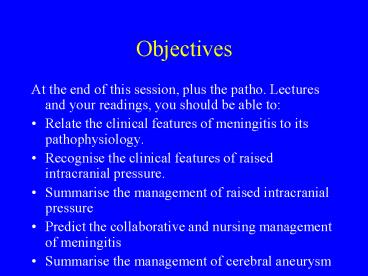Objectives - PowerPoint PPT Presentation
1 / 13
Title: Objectives
1
Objectives
- At the end of this session, plus the patho.
Lectures and your readings, you should be able
to - Relate the clinical features of meningitis to its
pathophysiology. - Recognise the clinical features of raised
intracranial pressure. - Summarise the management of raised intracranial
pressure - Predict the collaborative and nursing management
of meningitis - Summarise the management of cerebral aneurysm
2
Intracranial Infection1. Meningitis
- Definition
- inflammation of meninges
- Aetiology
- Viral
- Fungal
- BACTERIAL
- - Neisseria meningitides
- - Streptococcus pneumoniae
- - Haemophilus influenzae
3
Pathophysiology
- Nasopharyngeal infection
- Septicaemia (or direct spread)
- Inflamed meninges
- Thrombosis lt cerebral blood flow
- Meningeal exudate
- Profound alterations in IC physiology
4
Clinical Manifestations
- Infection
- Increased Intracranial Pressure
- Headache
- Fever/rash
- LOC changes
- Meningeal irritability
- - nuchal rigidity
- - Kernigs sign
- - Brudzinskis sign
- - Photophobia
5
Intracranial Pressure Determinants
- Monro-Kellie Hypothesis
- Brain Tissue 1,400g
- Blood 75mls
- CSF 75mls
- Intracranial Pressure (10-20mmHg)
6
Cerebral Response to Increased Intracranial
Pressure
- Autoregulation
- Functions up to systolic BP 60-160mmHg
- ICP lt 40mmHg
- Cushings response
- Cushings triad
- 1. Bradycardia
- 2. Hypertension
- 3. Bradypnoea
- Herniation and brain death
7
Clinical Manifestations of Increasing ICP
- EARLIEST
- - Change in LOC
- - Reslessness/drowsiness/confusion
- - Stuporous
- - Comatose
8
Assessment of Intracranial
PressureGCSPupilsVitalsCerebral
angiographyCTMRIPET
9
Management of Increased ICP
- Invasive monitoring of ICP
- Decreasing cerebral oedema
- Lowering the volume of CSF
- Decreasing blood volume
- - osmotic diuretics
- - corticosteroids
- - restricting fluids
- - draining CSF
- - hyperventilation
- - controlling fever-reducing met. demands
10
Management of Meningitis
- Assessment
- CSF Blood
- Prevention
- antimicrobial prophylaxis
- meningococcal vaccines
- Treatment
- - IV antibiotic
- - - Dexamethasone
- - Management of complications and ICP
11
Nursing Management
- Possible patient problems
- Fever
- Dehydration
- Cerebral oedema
- Seizures
- Airwary obstruction
- Resp/cardiac arrest
12
Intracranial Aneurysm
- Definition
- dilation of arterial wall due to weakness
- Pathophysiology
- symptoms when aneurysm presses cranial nerves or
brain tissue, or when rupture causes subarachnoid
haemorrhage - Assessment
- CT, Lumbar puncture
- Hunt-Hess grades (table 59-1)
13
Aneurysm (cont.d)
- Management
- Goals
- - allow brain to recover
- - minimise risk for re-bleeding
- - prevent and treat other complications
- Bed rest, sedation, - surgical intervention































